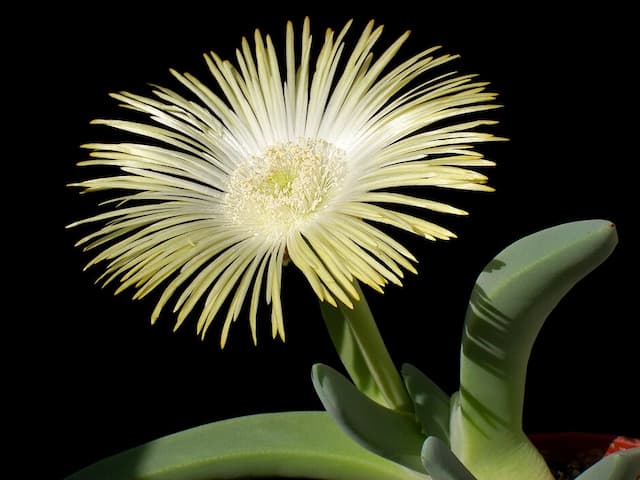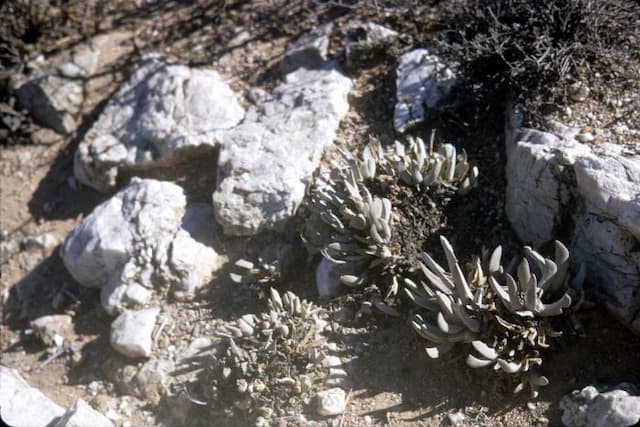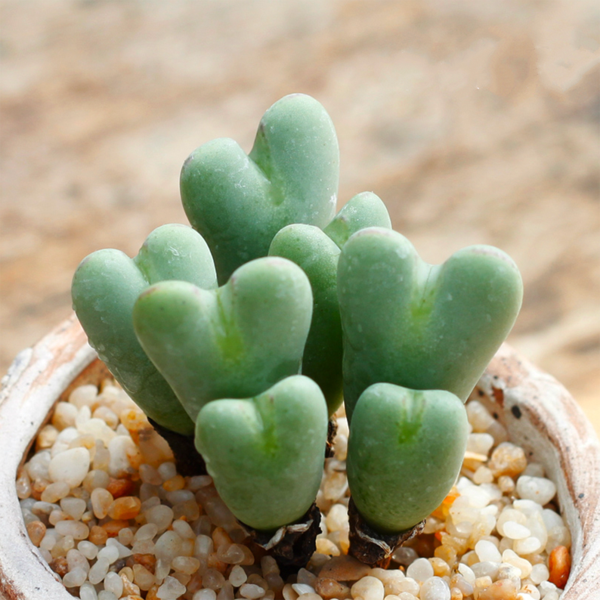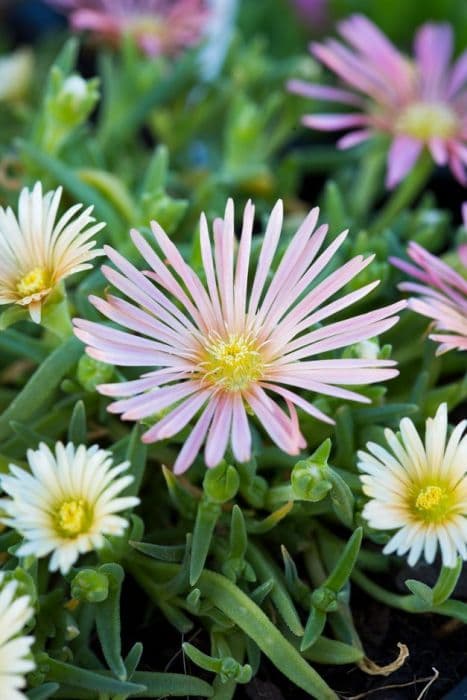Living Stone Conophytum flavum

ABOUT
The Conophytum flavum, more widely known as a type of Dumpling or Button Plant, is a captivating succulent that is quite a sight to behold. Its appearance is strikingly unique: it consists of plump, almost rounded bodies that often look like a pair of green to yellowish-green leaves fused together at the base. The surface of these leaf bodies is smooth, occasionally bearing tiny marks or dots. During the flowering season, it produces vibrant, daisy-like flowers rising from the crevice between the leaf-like bodies. The blooms are bright yellow, adding a cheerful contrast to the plant's greenery, and are composed of many small, delicate petals that form an eye-catching display. This plant tends to form dense clusters, with new leaf pairs sprouting at the base of the previous season's growth, creating a compact, mound-like appearance. The overall visual impact of Conophytum flavum is that of a miniature, fleshy rock garden dotting the landscape with splashes of yellow when in bloom.
About this plant
 Names
NamesFamily
Aizoaceae.
Synonyms
Yellow Cone Plant, Conophytum.
Common names
Conophytum meyeri, Conophytum ernianum, Conophytum minimum, Conophytum flavum subsp. novicium, Conophytum novicium
 Toxicity
ToxicityTo humans
Conophytum flavum, commonly known as Cone Plants, is not widely known for toxicity towards humans. As with many succulents, Conophytum species are generally not regarded as poisonous. However, it is always advisable to practice caution and avoid ingestion of plant parts since comprehensive toxicity data may be lacking. If exceptions exist and a particular Conophytum species is toxic, symptoms could potentially include gastrointestinal discomfort, such as nausea, vomiting or diarrhea. It is important to remember that even non-toxic plants can cause problems if allergic reactions occur or if they are consumed in large quantities.
To pets
Cone Plants, the common name for Conophytum flavum, are not commonly recognized as toxic to pets. Typically, succulents from the Conophytum genus are considered safe and do not pose a significant threat when it comes to toxicity. However, pet owners should still be cautious and prevent pets from ingesting plants because certain individuals may have sensitive reactions, and comprehensive information on toxicity might be incomplete. If any Conophytum species were found to be toxic to pets, potential symptoms might include gastrointestinal upset such as vomiting or diarrhea. As some animals are more sensitive to particular plants, it’s best to keep all unknown plants out of reach of pets.
 Characteristics
CharacteristicsLife cycle
Perennials
Foliage type
Evergreen
Color of leaves
Varies
Flower color
Yellow
Height
2 inches [5 cm]
Spread
2 inches [5 cm]
Plant type
Succulent
Hardiness zones
10
Native area
South Africa
Benefits
 General Benefits
General Benefits- Low Maintenance: Conophytum flavum, also known as Dumpling Plant, requires minimal watering and care, making it ideal for busy individuals or those new to plant care.
- Drought-Tolerant: As a succulent, it is highly drought-resistant, which is perfect for arid climates and water conservation efforts.
- Easily Propagated: The Dumpling Plant can be easily propagated from offsets or leaf cuttings, allowing gardeners to expand their collection or share with friends.
- Interesting Aesthetic: With its unique shape and bright yellow flowers, it adds an interesting visual appeal to rock gardens, terrariums, and succulent displays.
- Compact Size: Its small stature makes it ideal for windowsills, desktops, and small spaces where larger plants might not fit.
- Seasonal Interest: It blooms in autumn, providing a seasonal interest when many other plants may be dying back or preparing for winter.
 Medical Properties
Medical PropertiesThis plant is not used for medical purposes.
 Air-purifying Qualities
Air-purifying QualitiesThis plant is not specifically known for air purifying qualities.
 Other Uses
Other Uses- Conophytum flavum, commonly called "Dumpling Plant," can be aesthetically used in miniature fairy gardens due to its small, unique shape resembling tiny rocks or pebbles.
- The plant can be part of educational projects or botanical studies that focus on succulents' water storage strategies and adaptation to arid environments.
- In photography and art, the Dumpling Plant provides interesting textures and forms for macro photography, still life compositions, or botanical illustrations.
- Dumpling Plant can be grown in small containers or terrariums as a living ornament on office desks, showcasing the beauty of small-scale gardening.
- They can be used as a natural tool to teach children about plant care and responsibility, considering their low-maintenance needs and resilience.
- Conophytum flavum can serve as an indicator species in a collection, its health reflecting the growing conditions that affect other nearby succulents.
- The unique appearance of Dumpling Plant can inspire designers and artists in creating patterns, textures, or concepts for home décor and fashion.
- It can be used in culinary presentations as a non-toxic decorative element alongside dishes that require a natural touch without the intention of being eaten.
- During festive seasons, these plants can be used as living decorations in wreaths or as part of a botanical advent calendar due to their small size and unique appearance.
- For hobbyists who enjoy propagating plants, Dumpling Plant provides an opportunity to experiment with succulent seed sowing and offset propagation techniques.
Interesting Facts
 Feng Shui
Feng ShuiThe Conophytum flavum is not used in Feng Shui practice.
 Zodiac Sign Compitability
Zodiac Sign CompitabilityThe Conophytum flavum is not used in astrology practice.
 Plant Symbolism
Plant Symbolism- Resilience and self-sufficiency: Conophytum flavum, commonly known as "Cone plants," are succulents that store water in their leaves allowing them to survive in arid environments, symbolizing the ability to thrive despite challenging conditions.
- Uniqueness and individuality: Each Cone plant has a distinct shape and pattern, representing uniqueness and encouraging the celebration of one's individual traits.
- Persistence: Cone plants grow slowly and can live for many years, symbolizing persistence and the rewards of patience and long-term thinking.
- Adaptability: As a plant that can adapt to harsh environments, Cone plants represent flexibility and the capacity to adjust to various situations in life.
 Water
WaterThe Conophytum flavum, commonly known as the Button Plant, requires minimal watering, following the "soak and dry" method. Water the plant thoroughly until excess water drains out of the bottom, then allow the soil to completely dry before watering again. This succulent typically needs water once every two weeks during active growth in fall and winter, but during the summer dormancy, water sparingly, only once a month at most. It is crucial not to overwater as it can lead to root rot. An average of 2 ounces per watering session is adequate for a small Button Plant.
 Light
LightConophytum flavum, or Button Plant, thrives in bright, indirect light. It is best positioned in a spot that receives plenty of light but is shielded from the harsh midday sun, which can scorch its leaves. A south-facing window with a sheer curtain or an east-facing window that provides gentle morning light is ideal for the Button Plant.
 Temperature
TemperatureButton Plants are best kept at temperatures between 50°F and 75°F. They can tolerate a short period of colder temperatures down to 40°F but should never be exposed to frost. During the summer months, make sure the temperature does not exceed 85°F as excessive heat can stress the plant.
 Pruning
PruningPruning of the Button Plant is generally not necessary. These plants naturally shed old leaves as new growth emerges. However, if you need to remove dead leaves or tidy the plant’s appearance, do so very gently, as the fleshy leaves can easily be damaged. Pruning, if needed, should occur at the end of the dormancy period, before the new growth cycle begins.
 Cleaning
CleaningAs needed
 Soil
SoilThe best soil mix for Conophytum flavum, commonly known as Button Plant, is a well-draining cactus or succulent mix with added perlite or pumice for increased aeration. A top layer of fine gravel can help to mimic their natural rocky habitats. The ideal soil pH for Button Plants should be slightly acidic to neutral, ranging between 5.5 and 7.5.
 Repotting
RepottingButton Plants should be repotted every 2 to 3 years or when they have outgrown their current container. It's best to repot during their active growing season, which is in the fall and early winter months for Conophytum flavum.
 Humidity & Misting
Humidity & MistingButton Plants prefer low to moderate humidity levels, as they are native to arid environments. Maintaining indoor humidity levels between 10% and 30% is suitable for the optimal health of Conophytum flavum.
 Suitable locations
Suitable locationsIndoor
Ensure bright light, well-draining soil, and sparse watering for Button Plant indoor care.
Outdoor
Place Button Plants in a sunny spot with well-draining soil and minimal water outdoors.
Hardiness zone
10-11 USDA
 Life cycle
Life cycleThe life cycle of Conophytum flavum, also known as Cone Plants, begins with the germination of seeds, which typically occurs in the fall, as cooler temperatures and moisture are more favourable for growth. After germination, Conophytum flavum develops into a small, compact succulent with two fleshy, fused leaves and no true stem; during this juvenile stage, the plant focuses on photosynthesis and root development. As it matures, the plant enters a growth phase where new leaf pairs, known as bodies, are produced annually from a fissure between the old leaves; during this period, the older leaves dry out and form a protective sheath around the new growth. Cone Plants exhibit a distinct rest period during the hot and dry summer months, where the metabolism slows down, and the plant goes dormant to conserve resources. Flowering typically occurs in late summer to fall when the plant breaks dormancy, producing vibrant daisy-like flowers that emerge from the centre of the leaf pair. After pollination, seeds are set, and once mature, they are dispersed to complete the cycle, while the parent plant continues to grow and produce new bodies each year.
 Propogation
PropogationPropogation time
Late summer to fall
Conophytum flavum, commonly known as dumpling plant or button plant, is best propagated through seeds, which is the most popular method. The optimal time for sowing seeds is in the fall season after the hot summer has passed. Sow the seeds in a well-draining soil mix, lightly covering them with a thin layer of sand or finely sifted soil. Keep the soil moist by regularly misting with water, and place the container in a warm area with bright, indirect sunlight. Germination can take several weeks, and it's crucial to avoid overwatering during this period to prevent fungal infections. Once the seedlings are large enough to handle, they can be gently transplanted into individual pots.









